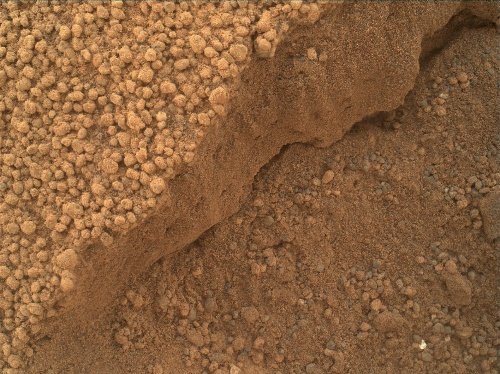Yet another milestone for this mission; the speakers at today's telecon announced that they have received confirmation that the chemistry and mineralogy instrument has received a portion of the third sample. They haven't given SAM any yet because 'it isn't ready yet' so they'll do all of this again when they're ready.
Concerning the sparkling bits I talked about recently, apart from the hunch that these particles are probably native to Mars and therefore not a threat to Curiosity's analysis (which is why they the second dig took a little longer while they mulled over the matter) they haven't much more about what they are. They gave probable reasons for their anomalous appearance including the mineralogical ones (cleavage, refracting light and all other sorts of geological grammar).
They gave a good talk about what they see in the sample that's already on the tray. They noted that there are 2 kinds of particles based on size. The coarser type are darker compared to the finer ones which are so light that they allow most of the tray's reflected light to pass through unimpeded, giving them a much lighter appearance compared to when they were still in the drift.
 |
| Mastcam image of the sample on the tray (NASA/JPL/MSSS) |
They mentioned importantly that this all means that we have 3 size-classes of particles here, large particles (in the range of millimetres) which sort of armour the drifts of finer material, preventing them from moving with the wind as they are simply too heavy for Mars' low density air to move. Below this armour there is the finer particles that are (I think) the coarse, dark-coloured particles that we see on the tray. Anything finer is probably dust. All finer components are at or below 150 micron level and they are light enough to be lifted up by winds. Enough to evenly distribute them across the planet. So by analyzing them, we can learn a lot about global Martian dust and drift material because these samples are representative of the whole of Mars rather than local (which would include things that can't be moved very far like the coarse armour material).
 |
Sol 67 MAHLI image of the second dig. Notice the top, coarser armour layer and the finer material below
(NASA/JPL/MSSS) |
Chemical analyses of Martian materials isn't all that special but CheMin is important because it can actually analyse the mineralogical makeup of samples which is unprecedented in Mars exploration!
It's now 6: 30am on sol 72 of Curiosity's mission at Gale crater. Stay tuned!


No comments:
Post a Comment